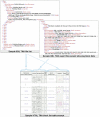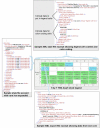The tissue micro-array data exchange specification: a web based experience browsing imported data
- PMID: 16086837
- PMCID: PMC1208890
- DOI: 10.1186/1472-6947-5-25
The tissue micro-array data exchange specification: a web based experience browsing imported data
Abstract
Background: The AIDS and Cancer Specimen Resource (ACSR) is an HIV/AIDS tissue bank consortium sponsored by the National Cancer Institute (NCI) Division of Cancer Treatment and Diagnosis (DCTD). The ACSR offers to approved researchers HIV infected biologic samples and uninfected control tissues including tissue cores in micro-arrays (TMA) accompanied by de-identified clinical data. Researchers interested in the type and quality of TMA tissue cores and the associated clinical data need an efficient method for viewing available TMA materials. Because each of the tissue samples within a TMA has separate data including a core tissue digital image and clinical data, an organized, standard approach to producing, navigating and publishing such data is necessary. The Association for Pathology Informatics (API) extensible mark-up language (XML) TMA data exchange specification (TMA DES) proposed in April 2003 provides a common format for TMA data. Exporting TMA data into the proposed format offers an opportunity to implement the API TMA DES. Using our public BrowseTMA tool, we created a web site that organizes and cross references TMA lists, digital "virtual slide" images, TMA DES export data, linked legends and clinical details for researchers. Microsoft Excel and Microsoft Word are used to convert tabular clinical data and produce an XML file in the TMA DES format. The BrowseTMA tool contains Extensible Stylesheet Language Transformation (XSLT) scripts that convert XML data into Hyper-Text Mark-up Language (HTML) web pages with hyperlinks automatically added to allow rapid navigation.
Results: Block lists, virtual slide images, legends, clinical details and exports have been placed on the ACSR web site for 14 blocks with 1623 cores of 2.0, 1.0 and 0.6 mm sizes. Our virtual microscope can be used to view and annotate these TMA images. Researchers can readily navigate from TMA block lists to TMA legends and to clinical details for a selected tissue core. Exports for 11 blocks with 3812 cores from three other institutions were processed with the BrowseTMA tool. Fifty common data elements (CDE) from the TMA DES were used and 42 more created for site-specific data. Researchers can download TMA clinical data in the TMA DES format.
Conclusion: Virtual TMAs with clinical data can be viewed on the Internet by interested researchers using the BrowseTMA tool. We have organized our approach to producing, sorting, navigating and publishing TMA information to facilitate such review. We have converted Excel TMA data into TMA DES XML, and imported it and TMA DES XML from another institution into BrowseTMA to produce web pages that allow us to browse through the merged data. We proposed enhancements to the TMA DES as a result of this experience. We implemented improvements to the API TMA DES as a result of using exported data from several institutions. A document type definition was written for the API TMA DES (that optionally includes proposed enhancements). Independent validators can be used to check exports against the DTD (with or without the proposed enhancements). Linking tissue core images to readily navigable clinical data greatly improves the value of the TMA.
Figures






Similar articles
-
The tissue microarray data exchange specification: a document type definition to validate and enhance XML data.BMC Med Inform Decis Mak. 2005 May 4;5:12. doi: 10.1186/1472-6947-5-12. BMC Med Inform Decis Mak. 2005. PMID: 15871741 Free PMC article.
-
The tissue microarray data exchange specification: a community-based, open source tool for sharing tissue microarray data.BMC Med Inform Decis Mak. 2003 May 23;3:5. doi: 10.1186/1472-6947-3-5. Epub 2003 May 23. BMC Med Inform Decis Mak. 2003. PMID: 12769826 Free PMC article.
-
Extending the tissue microarray data exchange specification for inclusion of data analysis results.J Pathol Inform. 2011 Mar 31;2:17. doi: 10.4103/2153-3539.78263. J Pathol Inform. 2011. PMID: 21572505 Free PMC article.
-
XML for data representation and model specification in neuroscience.Methods Mol Biol. 2007;401:53-66. doi: 10.1007/978-1-59745-520-6_4. Methods Mol Biol. 2007. PMID: 18368360 Review.
-
From telepathology to virtual pathology institution: the new world of digital pathology.Rom J Morphol Embryol. 1999-2004;45:3-9. Rom J Morphol Embryol. 1999. PMID: 15847374 Review.
Cited by
-
The tissue microarray OWL schema: An open-source tool for sharing tissue microarray data.J Pathol Inform. 2010 Jul 13;1:9. doi: 10.4103/2153-3539.65347. J Pathol Inform. 2010. PMID: 20805954 Free PMC article.
-
Overexpression of EZH2/NSD2 Histone Methyltransferase Axis Predicts Poor Prognosis and Accelerates Tumor Progression in Triple-Negative Breast Cancer.Front Oncol. 2021 Feb 16;10:600514. doi: 10.3389/fonc.2020.600514. eCollection 2020. Front Oncol. 2021. PMID: 33665162 Free PMC article.
-
The AIDS and Cancer Specimen Resource: role in HIV/AIDS scientific discovery.Infect Agent Cancer. 2007 Mar 2;2:7. doi: 10.1186/1750-9378-2-7. Infect Agent Cancer. 2007. PMID: 17335575 Free PMC article.
References
-
- AIDS and Cancer Specimen Resource web site http://acsr.ucsf.edu
-
- Nohle DG, Hackman BA, Ayers LW. Web-based virtual tissue micro-array slides with clinical data for researchers in HTML, Excel® and API standard XML data exchange specification formats produced with Microsoft Office ®applications http://www.acsr.mid-region.org/ [abstract] Proceedings of the Advancing Pathology Informatics Imaging and the Internet 8th annual conference: 8–10 October 2003; Pittsburgh, Pennsylvania. http://apiii.upmc.edu/abstracts/posterarchive/2003/nohle.html
-
- Nohle DG, Hackman BA, Ayers LW. Tissue micro-array data TMA standard and public tool for linked legend and clinical details at http://acsr.mid-region.org [abstract] Proceedings of the 8th International Conference on Malignancies in AIDS and Other Immunodeficiencies (ICMAOI): Basic, Epidemiologic and Clinical Research: 29–30 April 2004. p. 98.http://www.nci.nih.gov/dctd/aids/abstracts.pdf
-
- Nohle DG, Hackman BA, Ayers LW. A document type definition for the API standard tissue micro-array XML data exchange specification http://www.acsr.mid-region.org/[abstract] Proceedings of the Advancing Practice, Instruction and Innovation through Informatics 9th annual conference: 6–8 October 2004; Pittsburgh, Pennsylvania. http://apiii.upmc.edu/abstracts/DISPLAY.CFM?ID=317
-
- Kononen J, Bubendorf L, Kallioniemi A, Barlund M, Schraml P, Leighton S, Torhorst J, Mihatsch MJ, Sauter G, Kallioniemi OP. Tissue microarrays for high-throughput molecular profiling of tumor specimens. Nat Med. 1998;4:844–847. doi: 10.1038/nm0798-844. http://www.biomedcentral.com/pubmed/9662379 - DOI - PubMed
Publication types
MeSH terms
Grants and funding
LinkOut - more resources
Full Text Sources
Miscellaneous

